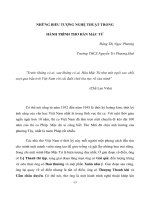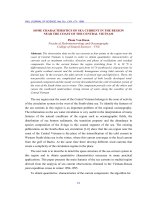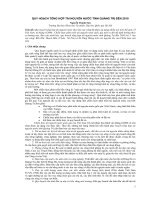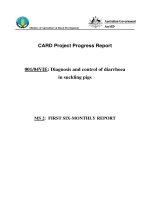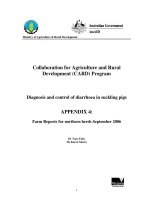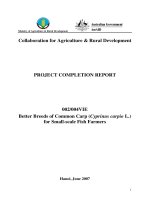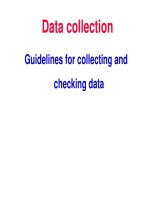Báo cáo nghiên cứu khoa học " ANTIGENIC DIAGNOSIS OF ROTAVIRUS, CORONAVIRUS AND ESCHERICHIA COLI K99 IN CALVES'''' FAECES " docx
Bạn đang xem bản rút gọn của tài liệu. Xem và tải ngay bản đầy đủ của tài liệu tại đây (4.32 MB, 22 trang )
NATIONAL INSTITUTE OF VETERINARY RESEARCH
ENTERIC DISEASES DIAGNOSTIC REQUEST FORM
Signed ………………………………………………………… Date…………………………
NIVR – Attn: Department of Bacteriology (Dr Cu Huu Phu)
Postal Address
86 Truong Chinh Rd
Dong Da-Hanoi
Phone 84 48693923
Fax 84 48694082
Please complete ALL sections. Complete ONE form for each sow. Multiple piglets from the same sow can be entered on a
SINGLE form.
Farm Owner:
Number of sows:
Address:
Phone: Fax:
Email:
Mobile:
NIVR Use Only:
TEST FARM NUMBER:
LABORATORY SUBMISSION NUMBER:
Contact details of person collecting specimen:
Name: Occupation:
Address:
Province: Postcode:
Telephone: Fax: Email:
Date of Collection:
Breed:
Sow
ID
Par-ity Date of
birth
Litter
size
Foster
pigs
Number of piglets
with diarrhoea
Duration Sample type Treated?
(Y/N)
1
2
3
4
5
6
7
Preliminary Diagnosis/History (Treatments, severity of scour etc)
Reports to be sent
Vet Other: Name Fax No
Property
Manager
Other: Name Fax No
NATIONAL INSTITUTE OF VETERINARY RESEARCH
ENTERIC DISEASES DIAGNOSTIC REQUEST FORM
Signed ………………………………………………………… Date…………………………
Characteristics of faecal specimens:
Sample No: pH: Colour: Consistency (Scale
1-4):
(1 = thick custard; 4 = pure water)
Parasitology:
Isospora suis (Faecal float):
Cryptosporidium (MZN):
Bacteriology:
Other:
Virology (TGE)
DIPSTICK (Herd only):
ELISA:
Immunoflourescence:
Virology (Rotavirus)
ELISA:
Diagnosis
ID No: Date:
NATIONAL INSTITUTE OF VETERINARY RESEARCH
ENTERIC DISEASES DIAGNOSTIC REQUEST FORM
Signed ………………………………………………………… Date…………………………
Pre-weaning diarrhoea in pigs (PrWD) is a complex
problem involving a large number of causative agents:
transmissible gastroenteritis virus (TGEV), rotavirus
(RV), enterotoxigenic E. coli (ETEC), Clostridium
perfringens (C. per.), coccidiosis due to Isospora suis
(Cocci), and Cryptosporidium (Crypto) [1].
The predominant causes of PrWD and their relative
contribution to morbidity vary between countries, and
have continuously changed over time, due to the
adoption of new management practices and the
emergence of new diseases. In addition, some
pathogens are restricted to certain geographical
locations [2].
A comprehensive survey of the major causative agents
of PrWD has not been attempted previously in Vietnam.
CAUSES OF PRE-WEANING DIARRHOEA IN COMMERCIAL
AND VILLAGE PIGS IN VIETNAM
Do NT
1
, Nguyen XH
1
, Au XT
1
, Cu HP
1
, Fahy VA
2
, Cargill C
3
, and Trott DJ
4
1
National Institute of Veterinary Research, Hanoi, Vietnam
2
National
E. coli
Reference Laboratory, Department of Natural Resources and Environment, Epsom, VIC 3554, Australia
3
The South Australian Research and Development Institute (SARDI), Adelaide SA 5001, Australia
4
School of Veterinary Science, The University of Queensland, Brisbane, QLD 4072
INTRODUCTION
OBJECTIVES
MATERIAL AND METHODS
RESULTS
REFERENCES
Table 1: The contribution of different infectious agents to
PrWD in commercial and village pigs
# of positive specimens (%)Agent(s) detected
45 (100.0)92 (78.8)
Total multiple infections
(23)(76)(111)(97)(50)
(36)
1 (0.8)
C. per.ETECTGEVRVCrypto
1 (2.2)1 (0.8)
C. per.TGEVRVCryptoCocci
1 (2.2)4 (3.4)
ETECTGEVRVCocci
1 (0.8)
C. per.TGEVCryptoCocci
1 (2.2)1 (0.8)
TGEVRVCryptoCocci
2 (4.4)1 (0.8)
C. per.
ETEC
RVCrypto
1 (2.2)2 (1.7)
ETEC
TGEVRVCrypto
2 (1.7)
C. per.
ETEC
TGEV
3 (6.7)2 (1.7)
C. per.
ETEC
RV
1 (2.2)1 (0.8)
C. per.TGEVRV
7 (15.6)14 (11.9)
ETECTGEVRV
3 (2.5)
TGEVRVCrypto
1 (2.2)1 (0.8)
C. per.TGEVCrypto
3 (6.7)1 (0.8)
ETECRVCrypto
4 (4.4)5 (4.2)
ETECTGEVCrypto
1 (2.2)1 (0.8)
RVCryptoCocci
2 (4.4)2 (1.7)
ETECTGEVCocci
3 (6.7)4 (3.4)
TGEVRVCocci
3 (6.7)2 (1.7)
ETECRVCocci
7 (5.9)
ETECTGEV
1 (0.8)
C. per.TGEV
2 (4.4)6 (5.1)
TGEVCrypto
1 (2.2)1 (0.8)
C. per.Crypto
1 (2.2)3 (2.5)
ETECCrypto
2 (4.4)1 (0.8)
CryptoCocci
2 (4.4)1 (0.8)
RVCocci
3 (6.7)17 (14.4)
TGEVRV
6 (5.1)
ETECRV
25 (21.2)
Total single infections
2 (1.7)
C. per.
4 (3.4)
ETEC
11 (9.3)
TGEV
3 (2.5)
RV
3 (2.5)
Crypto
2 (1.7)
Cocci
Village
(n=45)
Commercial
(n=117)
To determine the prevalence of the six major causes of
pre-weaning diarrhoea in commercial (CP) and village
pigs (VP) in Vietnam.
117 (from CP) and 45 (from VP) faecal specimens were
collected from cases of PrWD fro 6/2005 to 3/2008.
All samples were tested for the presence of: 1) Cocci;
and 2) Crypto oocysts by standard faecal flotation and
modified Ziehl-Neelsen staining of faecal smears,
respectively; 3) RV; and 4) TGEV using an ELISA kit
(Institut Pourquier, France); 5) ETEC by aerobic culture
and PCR for enterotoxins and fimbriae; and 6) C.
perfringens by anaerobic culture. Results were
interpreted according to manufacturer’s
recommendations (ELISA kit) or as described [3].
Detection of multiple infectious agents from a single
specimen was common, with TGEV and RV being
endemic to all piggeries (Table 1).
In village pigs, agents were always found together with
one or more additional agents, while 25 cases from CP
were infected with only 1 causative agent.
ETEC occurred in older (>4 day-old) piglets; most
probably due to effective vaccination programs.
These results and observations from farm audits
suggest that environmental conditions and husbandry
practices may be predisposing piglets to intestinal
infections.
1. Straw, B. E., et al. Diseases of Swine 1999: 41-59.
2. Tzipori, S. British Veterinary Journal 1988; 144: 521-523.
3. Diagnostic Manual of the Pig Health and Research Unit (Bendigo,
Victoria, Australia).
ACKNOWLEDGMENTS
This work was supported by Ministry of Agriculture & Rural
Development (Vietnam), National Institute of Veterinary
Research (NIVR), Australian Government (AusAID) under
Collaboration for Agriculture and Rural Development (CARD)
Program
2
Escherichia coli is one of the most important
enteric pathogens causing diarrhoea in pigs [1]
Pathogenic E. coli often colonize the small intestine
by means of adhesion factors and produce one or
several disease-causing toxins [1]
Detection of virulence factors by molecular
techniques such as DNA hybridization and PCR has
been shown to be the most effective tool to
evaluate if an E. coli isolated obtained from
diseased pigs is pathogenic and to provide suitable
measures of control and prevention [2]
1. Bertschinger HU, Fairbrother JM. Escherichia coli infections.
In: Straw BE, D'Allaire S, Mengeling WL, Taylor DJ, editors.
Diseases of Swine. Ames, Iowa: Iowa State University Press;
1999. p. 431-468.
2. 2. Wray C, Woodward MJ. Laboratory diagnosis of Escherichia
coli infections. In: Gyles CL, editor. Escherichia coli in
Domestic Animals and Humans. Wallingford, England: CAB
International; 1994. p. 595-628.
ACKNOWLEDGMENTS
This work was supported by Ministry of Agriculture & Rural
Development (Vietnam), National Institute of Veterinary
Research (NIVR), Australian Government (AuAID) under
Collaboration for Agriculture and Rural Development (CARD)
Program
Virulence characterizations of Vietnamese strains of E.
coli causing diarrhoea in pigs in Vietnam
Do NT
1
, Trott DJ
2
, Desautels C
3
, Fairbrother JM
3
1
Department of Bacteriology, National Institute of Veterinary Research, Hanoi, Vietnam
2
School of Veterinary Science, The University of Queensland, Brisbane, QLD 4072, Australia
3
The
Escherichia coli
Laboratory, Faculte de Medicine Veterinaire, Universite de Montreal, 3200 Sicotte, Saint-Hyacinthe, QC,
Canada J2S 2M2
INTRODUCTION
OBJECTIVES
MATERIAL AND METHODS
RESULTS
REFERENCES
Table 1: Prevalence of individual virulence gene
1 (5.6%)Aero
7 (17.1%)14 (77.8%)EAST1
28 (68.3%)STx2
23 (56.1%)12 (66.7%)LT
20 (48.8%)16 (88.9%)STb
31 (75.6%)14 (77.8%)STa
13 (31.7%)2 (11.1%)AIDA-I
25 (61.0%)13 (72.2%)
Paa
30 (73.2%)
F18
2 (11.1%)
F5
6 (14.6%)9 (50.0%)F4
PWD (n=41)PrWD (n=18)
Source of isolates (%)
Virulence
factor
Table 2: The prevalence of different pathotypes
1STa/STb
2LT/Stx2
4Paa/STa/STb/LT/EAST1
1STb/EAST1
1AIDA-I/STb/LT/EAST1
2F4/Paa/STb/LT/EAST1
5F4/Paa/STb/LT/EAST1
1F4/STa/STb/EAST1
1F4/STa/STb/Aero
2F5/Paa/STa
1AIDA-I/STb/EAST1
2Paa/STa/LT/Stx2
13F18/Paa/STa/LT/Stx2
3F18/Paa/AIDA-I/STa/STb/Stx2
4F18/AIDA-I/STa/STb/Stx2
1F18/LT/Stx2
1F18/AIDA-I/STb/Stx2
2F18/Paa/AIDA-I/STa/Stx2
3F18/AIDA-I/STa/STb
1F18/STa/EAST1
2F18/STa/STb
5F4/ Paa/STa/STb/LT/EAST1
1F4/STa/STb
PWD (n=41)PrWD (n=18)
Source of isolates
Pathotype
To screen for the presence of 19 virulence factors
(F4, F5, F6, F17, F18, F41, EAE, P factor, Paa, AFA,
AIDA-I, STa, STb, LT EASTI, Stx1, Stx2, CNF, Aero)
in ETEC and ETEC/VTEC strains obtained from pig
with diarrhoea in Vietnam
E. coli strains (n=18 from pre-weaning and n=41
from post-weaning piglets with diarrhoea) from
different provinces in Vietnam
ETEC or ETEC/VTEC were confirmed by primary
multiplex PCR (F4, F5, F6, F41, F18, STa, STb, LT,
VT2e)
DNA hybridization and PCR were further applied to
detect for the presence of 19 virulence factors
according to the protocol of The Escherichia coli
Laboratory, Faculte de Medicine Veterinaire,
Universite de Montreal
3
The cost of pork production in Vietnam could be significantly reduced by the widespread use of locally made
efficacious vaccines to control endemic diseases such as neonatal colibacillosis.
DEVELOPMENT AND EFFICACY TESTING OF A VACCINE
FOR THE CONTROL OF PRE-WEANING COLIBACILLOSIS
IN VIETNAM
Cu HP
1
, Fahy VA
2
, Driesen SJ
2
, Moore K
2
, Vanderfeen A
2
, Do NT
1
, and Trott DJ
3
1
National Institute of Veterinary Research, Hanoi, Vietnam
2
National
E. coli
Reference Laboratory, Department of Natural Resources and Environment, Epsom, VIC 3554, Australia
3
School of Veterinary Science, The University of Queensland, Brisbane, QLD 4072
INTRODUCTION
1. VACCINE DEVELOPMENT
2. SAFETY TESTING
3. EFFICACY TESTING
Table 2: Summary of ELISA results on pre- and post-
vaccination sera samples
ACKNOWLEDGMENTS
This work was supported by Ministry of Agriculture & Rural
Development (Vietnam), National Institute of Veterinary Research
(NIVR), Australian Government (AuAID) under Collaboration for
Agriculture and Rural Development (CARD) Program
0.8695
b
NIVR
0.9406
b
EcoVac
0.8129
b
Litterguard
0.2260
a
Control
Mean (OD value)Treatment group
82
4
2
5
0
80
3
2
4
0
Piglets born alive
Stillbirths
Mummies (or died before
parturition)
Deformities eg splay legs
Abortion
Group 2
(8 sows)
(NIVR)
Group 1
(8 sows)
(Litterguard)
Recorded criteria
Table 1: Recorded criteria on safety study
O64: F5/STa/STb/LTCARD-VN3
O149: K91:F4/STa/STb/LT CARD-VN2
O8:5F-/STa/STb/LTCARD-VN1
Virulence determinantsDesignation of strains
Table 1: E. coli strains used for the preparation of vaccine
1 ml of inactivated whole cell vaccine contains 7.5 x 10
9
bacteria
Naïve sows each received 2 ml of vaccine
(approximately 1.5 x 10
10
bacteria) at 9 and 12 weeks
of gestation
No local or systemic reaction to the vaccine was
observed and all sows gave birth at the correct stage of
gestation to an average of 10 healthy piglets per sow
High antibody titers to F4 antigen were detected (as
assessed by ELISA) for all three vaccines (p>0.1)
compared to an unvaccinated control group
(p<0.005).
There was no significant difference between the
antibody response elicited (as demonstrated by OD
values) by Litterguard, Ecovac or NIVR vaccines.
a
,
b
: p<0.005
4
Some technical solutions suitable for development
of smallholder pig production in Quang Tri
province
Duyen T.T.B
1
, Coi N.Q
1
, C Cargill
2
, VA Fahy
3
, DJ Trott
4
.
1
National Institute of Animal Husbandry, Hanoi, Vietnam;
3
South Australian Research
Development Institute,
2
Victorian Department of Primary Industries;
4
School of Veterinary
Science, The University of Queensland, Australia.
Introduction
√ Quang Tri province is located on the coast of
Central in Vietnam, where always adversely affected
by extremely harsh climate. Almost of the total pig
population in Quang Tri are raised in traditional
smallholder systems. Therefore, suitable technical
solutions for development of pig production under
household condition are necessary and should bring
benefits for farmers. This subject was funded by
CARD project 004/05VIE.
Materials and Methods
The animals in the experiment were Mong Cai
sows (MC) and F1 crossbred (Mong Cai x Yorkshire).
The experiment was conducted at 30 households in
Hai Phu and Hai Thuong communes .
Implement technical solutions that were selected,
Evaluate performance and economical efficience of
pig production through applying technical solutions.
Results
Overall, with new technical solutions: Breeds,
feeding, using creep box for warming piglets and
training piglets to eat “Start feed” brought high
economical efficience.
Objectives
√ To select suitable science technology in order
to develop pig production under household
condition in Quang Tri
Table 3: Testing of house selection for MC and F1 sows
Table 1: Reproductive physiology and performance of MC and F1 sows
1.2234.861.337.28Weaning period (days)
1.6254.962.1359.45Weaning weight/litter
0.518.780.6810.13Weaning number/litter (head)
0.5810.480.6511.72Number born alive/litter (head)
0.57
2.05
0.72
1.88Litters/sow/year (litter)
4.52334.006.59304.7
Age of First farrowing (day)
mxXmxX
F1MC
Criteria
Table 2: Reproductive performance of MC and F1 sows in Feeding experiments.
Within a row, values with different letters are significantly different (P<0.05)
423.40
b
393.53
a
526.27
a
464.14
a
Profit/litter (1000VND)
2051.73
a
2010.62
a
2184.27
a
2257.12
a
Total income/litter (1000VND)
1628.33
a
1617.1
b
1658.00
a
1792.98
a
Total cost/litter (1000VND)
120.69
a
125.66
a
128.49
a
141.07
a
Weight at 60 days of age/litter (kg)
8.50
a
9.80
a
8.50
a
10.00
a
Number of piglets at 60 days (head)
57.54
a
56.89
a
59.96
a
59.64
a
Weaning weight/litter (kg)
8.83
a
10.2
a
8.75
a
10.10
a
Weaning piglets/litter (head)
F1MCF1MC
Control groupExperimental groupCriteria
92.50
a
93.36
a
97.38
a
95.65
a
Alive weaning rate (%)
9.25
b
10.27
a
10.71
a
11.00
a
Weaning number/litter (head)
9.75
b
10.75
a
10.75
a
11.30
a
Piglets at 21 days of age/litter (head)
10.00
b
11.00
a
11.00
a
11.50
a
Number born alive/litter (head)
F1MCF1MC
Traditional styleModern style
Criteria
Table 4: Warming technique and training piglets to eat start feed
2346.00
a
2006.93
b
2573.80
a
2290.80
a
Income/litter (1000VND)
94.31
a
86.11
a
97.58
a
93.98
a
Alive piglet rate at 60 days of age (%)
14.83
a
13.07
a
15.10
a
14.08
a
Weight at 60 days of age/head (kg)
9.33
a
9.67
a
10.00
a
10.25
a
Number of piglets at 60 days
1.07
a
0.76
a
1.09
a
0.75
a
Birth weight/head (kg)
10.00
a
11.33
a
9.75
a
11.00
a
Number of piglets for raising/litter (head)
F2
(F1xY)
F1
(MCxY)
F2
(F1xY)
F1
(MCxY)
Control groupExperimental group
Criteria
Piglet creep boxes
Feeding piglets by “Start feed”
House for pigs with open side walls
5
6
Table 1: Results of diagnostic samples submitted to the lab (4/2005-10/2005)
Total No. of samples tested Causative agents No. of positive/Total %
E. coli
30/154 19.48%
Swab samples (n = 154)
C. perfringens
10/154 6.49%
Rotavirus 53/65 81.54%
Coronavirus 43/65 66.15%
Cocci oocytst 13/65 20.00%
Faecal samples tested (n = 65)
Crypto 9/65 13.85%
Table 2: Results of diagnostic samples submitted to Bacto Lab (11/2005-6/2006)
Total No. of samples tested Causative agents No. of positive/Total %
E. coli
19/113 16.81%
Swab samples (n = 113)
C. perfringens
7/113 6.19%
Rotavirus 61/74 82.43%
Coronavirus 49/74 66.22%
Cocci oocytst 14/74 18.92%
Faecal samples tested (n = 74)
Crypto 9/74 12.16%
Table 3. Common cause of scour in suckers
Agent Age of occurrence Sample Clinical Signs
NHEC 2hr-5 days Rectal swab or 2 gm of
faeces
Mild to severe scour,
dehydration death
Coccidia 5 – 15 days 2gm faeces Scour, death uncommon
HEC + 10 days through to
post weaning period
Rectal swab or 2 gm of
faeces
Sudden death from
endotoxemia shock or
severe scour with
dehydration
Table 2. Uncommon cause of scour in suckers
Agent Age of occurrence Sample Clinical Signs
Rotavirus, TGEV + 7 days into weaners 2 gm faeces Scouring, acidic faeces
Clostridium
perfringens type A
1 – 21 days 2 gm faeces Non responsive scour,
affects growth rate
Clostridium
perfringens type C
2 + days 2 gm faeces, whole
animal, small intestine
Severe haemorrhagic
enteritis
Salmonella 5 days of age to
weaning
Rectal swab, caecum
terminal iliium,
mesenteric lymph node,
whole animal
Scour, ill thrift, emaciation,
+/- pneumonia
Cryptosporidium 5 days of age to
weaning
2 gm faeces, whole
animal, small intestine
Scour (blood), ill-thrift
Stronyloides
ransomi
10 days to post
weaning
Faeces Severe diarhoea and
dehydration
